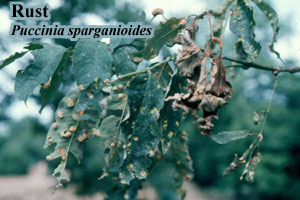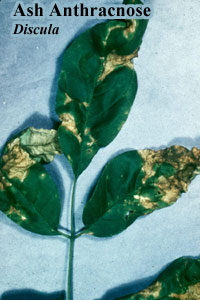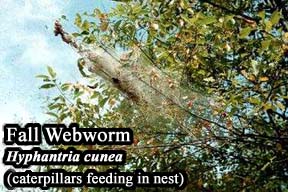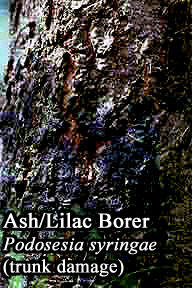Ash (Fraxinus)
Plant Health Problems
Diseases caused by Fungi: Rust, Puccinia sparganioides.
Rust, Puccinia sparganioides.
Raised, crescent-shaped, irregular swellings or yellow-orange spots develop on leaves or petioles. As the fungus develops in these areas, some distortion of tissue occurs. Heavily infected trees appear scorched from a distance. The fungus requires an alternate host (Spartina sp., marsh or cord grass) for the completion of its life cycle so the disease does not spread directly from ash to ash.
The infection may cause significant defoliation but appears to do little harm to the tree and chemical controls are usually not necessary. Maximizing the vigor of the tree by timely watering and fertilizer application is very important.
Leaf spot, Septoria.
Individual spots or large necrotic sections may develop on leaves during rainy weather, and some leaf drop may occur.
Removal of fallen leaves removes much of the source of inoculum for the following year. Fertilize trees in the spring and water well during drought to maintain tree vigor. Since this is usually not a serious problem for the health of the trees, chemical controls are usually not necessary. Anthracnose, Discula.
Anthracnose, Discula.
Newly emerging leaves develop brown spots at margins or tips, often resulting in distortion or twisting of the leaves. When infection is heavy, leaves quickly brown and fall prematurely. Tender young twigs can also be infected and die back. From a distance, individuals or clusters of heavily infected trees often have the appearance of being burned. This disease is favored by cool, wet spring weather.
Rake and remove fallen leaves and prune any affected twigs or limbs. It is also helpful to maintain tree vigor by fertilizing in spring and watering during periods of drought. Since this is not a serious problem for the health of the tree, chemical controls are usually not necessary.
Powdery mildew, Microsphaera.
White to grayish powdery growth develops on the leaves, usually on the upper surfaces first, fairly late in the season. This disease is favored by hot, humid weather.
Rake and dispose of the fallen leaves to reduce the chance of infection in the following season. Fertilize trees in the spring and water well during drought to maintain tree vigor. Since this disease is usually not a serious problem for the health of the trees, chemical controls are usually not necessary.
Diseases caused by Phytoplasmas:
Ash yellows, phytoplasma.
This disease causes a general decline of the trees. Subnormal growth, foliage in tufts or rosettes, leaves chlorotic, and the general appearance of sparse foliage are generally seen. Branches in all parts of the canopy may die, usually during dormant seasons.
Diagnosis is difficult, and there is no cure, but trees which are provided with water during dry seasons and fertilized in the spring will have a better chance of survival.
Insect Problems
Ash flower gall, Eriophyes fraxiniflora.
This mite causes a distortion of the staminate flowers of white ash, forming bunches or masses from 1/4 - 3/4" in diameter. These masses, visible throughout the year, finally dry and remain on the tree over the following winter. Dormant sprays of ultrafine horticultural oils, which are among the compounds registered for control of this pest in Connecticut, may prevent this development. Consult the label for dosage rates and safety precautions.
Ash sawfly, Tethida cordigera.
Occasionally, the leaves of white and green ash are devoured in May and June by sawfly larvae, which reach a length of nearly 3/4". They are pale greenish white, with a darker green median stripe, black head and legs. Carbaryl or malathion, which are among the compounds registered for control of this pest in Connecticut, can be sprayed on foliage if damage becomes intolerable. Consult the label for dosage rates and safety precautions.
 Fall webworm, Hyphantria cunea.
Fall webworm, Hyphantria cunea.
Webworms damage the leaves of ash by both feeding and web building. Webworms overwinter within cocoons located in protected places, such as crevices in bark or under debris and fences. Adult moths emerge in summer. They have a wingspan of about 1 1/4", and vary from pure satiny white to white thickly spotted with small dark brown dots. Females lay white masses of 400-500 eggs on the undersides of the leaves. The caterpillars hatch in 10 days, and all from the same egg mass live together as a colony. They spin webs that enclose the leaves, usually at the end of a branch, to feed upon them. After they have defoliated a branch, they extend their nest to include additional foliage. When caterpillars are mature, they leave the nest to seek a place to spin gray cocoons. The mature caterpillars are about 1 1/4" long with a broad dark brown stripe along the back, and yellowish sides thickly peppered with small blackish dots. Each segment is crossed by a row of tubercles with long light brown hairs. In Connecticut, there is one complete generation and a partial second one. In light infestations, pruning the nests and destroying them can destroy the webworms. In larger infestations, caterpillars can be controlled with foliar sprays of azadirachtin, Bacillus thuringiensis var. kurstaki, carbaryl, or spinosad. Consult the labels for dosage rates and safety precautions.

Lilac borer, Podosesia syringae.
The first evidence of damage is sap mixed with fine frass oozing from small irregularly shaped holes on infested branches. Rough swellings develop on infested limbs, branches may wilt and die outward from feeding sites, and branches may become weakened enough to break where larvae were tunneling. The larva is white with a brown head and is about 3/4" long. The clearwinged moths (which resemble paper wasps) lay their eggs in May and June. Pheromone traps are available to monitor moth activity. Winter is passed in the larval stage under the bark. For control, prune infested stems. Carbaryl or permethrin, which are among the compounds registered for control of this pest in Connecticut, may be applied to trunks and major limbs to kill the adults during their period of flight activity. Beneficial nematodes, Steinernema carpocapsae, can be applied to the bark of trunks and twigs to control larvae in their galleries. Consult the labels for dosage rates and safety precautions.

